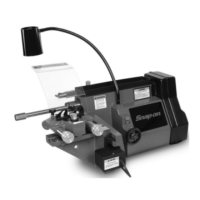Snap-on • 11
Reconditioning Brake
Drums
Measure the diameter of the brake drum with a
brake drum micrometer. Determine if the drum will be
within maximum rebore limits after reconditioning and
that its general condition is good.
Note: Most often the discard diameter is cast into
the brake drum, not the maximum “machine to” diam-
eter.
Figure 12
Set Up and Machining
1. Turn the end knob of the tool bar counterclock-
wise until the tool bit is fully retracted. Loosen the tool
bar clamp nut and pull or retract the tool bar all the
way back into the clamp.
2. Turn the drum slide handwheel counterclockwise
to move the slide to its maximum forward position.
3. Mount the drum on the arbor using the proper
adaptors, cones, and spacers as described in the pre-
ceding DRUM MOUNTING section.
4. Wrap the drum silencer band snugly around the
outside of the drum. Be sure the band fully covers the
drum.
Figure 13
5. Slide the tool bar into the drum. Position the
clamp and tool bar so the tool bit almost contacts the
brake surface at the back of the drum. Be sure the tool
bar is not touching the brake surface at the outer edge
of the drum, then tighten the clamp nut to about 25 ft.
lbs.
Note: The boring bar position must be changed
whenever preparing to machine a drum having a dif-
ferent diameter and/or depth than the previous drum.
6. Turn the drum slide handwheel clockwise to
move the tool bit to the outer edge of the brake sur-
face. Turn the lathe ON.
7. Check for drum runout. Runout is evident if the
outer edge of the drum moves closer to and then fur-
ther away from the tool bit while the drum is turning.
A very small amount of runout is permissible. A large
amount of runout indicates either a bent drum or an
incorrect mounting. To determine the cause of the
runout a “scratch cut” procedure can be used as out-
lined in steps 7A, 7B, and 7C.
7A Use the drum slide handwheel to move the tool
bit about 1/2" in from the outer edge of the drum.
Turn the end knob of the tool bar micrometer
clockwise until the tool bit lightly contacts the
drum surface making a “scratch cut”
approximately .001" deep. Turn the end knob of
the micrometer counterclockwise one (1) full turn
to move the tool bit away from the brake surface.
7B Turn the lathe OFF. Turn the drum slide
handwheel counterclockwise to move the tool bit
1/4" further into the drum. Loosen the arbor nut
and turn the drum 180˚ on the adaptors (do not
allow the adaptors to turn on the arbor).
Retighten the arbor nut. Turn the lathe ON.
Slowly turn the end knob of the micrometer
clockwise until a second “scratch cut” is made.
Turn the end knob of the micrometer
counterclockwise one (1) full turn.
7C Turn the lathe OFF. If the “scratch cuts” are side
by side the runout is in the drum and NOT in the
mounting. If the drum is not bent and the runout
is not severe, continue with step 8. A BENT
DRUM MUST BE REPLACED. If the “scratch
cuts” are opposite each other (180˚ apart) the
runout is caused by poor mounting. In this case,
inspect the mounting for cleanliness and the
adaptors for burrs, nicks, and scratches, as well
as the bearing races for wear and/or looseness.
Remount the drum and check for runout again. If
runout has been corrected, proceed to step 8.
Brake Lathes

